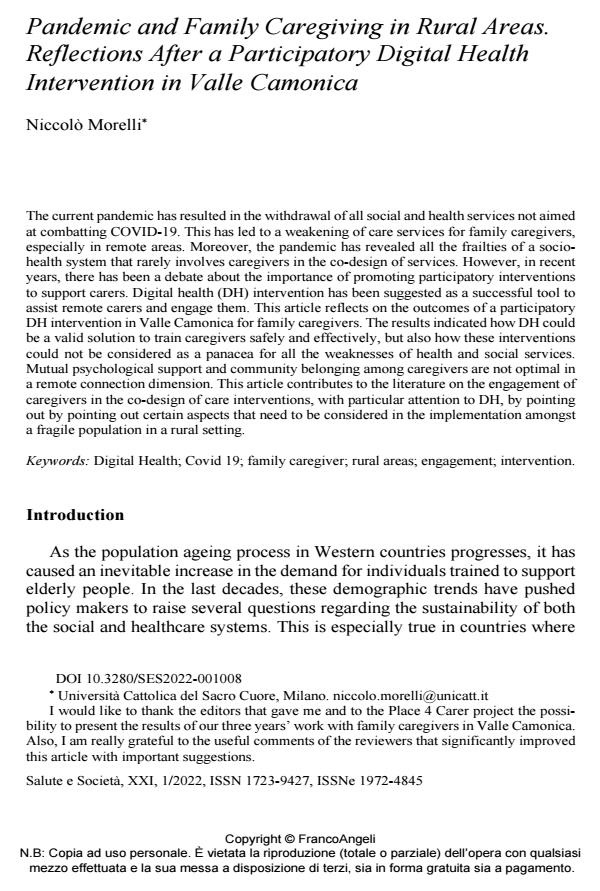Pandemic and Family Caregiving in Rural Areas. Reflections After a Participatory Digital Health Intervention in Valle Camonica
Titolo Rivista SALUTE E SOCIETÀ
Autori/Curatori Niccolò Morelli
Anno di pubblicazione 2022 Fascicolo 2022/1
Lingua Inglese Numero pagine 15 P. 113-127 Dimensione file 220 KB
DOI 10.3280/SES2022-001008
Il DOI è il codice a barre della proprietà intellettuale: per saperne di più
clicca qui
Qui sotto puoi vedere in anteprima la prima pagina di questo articolo.
Se questo articolo ti interessa, lo puoi acquistare (e scaricare in formato pdf) seguendo le facili indicazioni per acquistare il download credit. Acquista Download Credits per scaricare questo Articolo in formato PDF

FrancoAngeli è membro della Publishers International Linking Association, Inc (PILA)associazione indipendente e non profit per facilitare (attraverso i servizi tecnologici implementati da CrossRef.org) l’accesso degli studiosi ai contenuti digitali nelle pubblicazioni professionali e scientifiche
The current pandemic has resulted in the withdrawal of all social and health services not aimed at combatting COVID-19. This has led to a weakening of care services for family caregivers, especially in remote areas. Moreover, the pandemic has revealed all the frailties of a socio-health system that rarely involves caregivers in the co-design of services. However, in recent years, there has been a debate about the importance of promoting participatory interventions to support carers. Digital health (DH) intervention has been suggested as a successful tool to as-sist remote carers and engage them. This article reflects on the outcomes of a participatory DH intervention in Valle Camonica for family caregivers. The results indicated how DH could be a valid solution to train caregivers safely and effectively, but also how these interventions could not be considered as a panacea for all the weaknesses of health and social services. Mutual psychological support and community belonging among caregivers are not optimal in a remote connection dimension. This article contributes to the literature on the engagement of caregivers in the co-design of care interventions, with particular attention to DH, by pointing out by pointing out certain aspects that need to be considered in the implementation amongst a fragile population in a rural setting.
Parole chiave:Digital Health; Covid 19; family caregiver; rural areas; engagement; intervention.
- Active ageing in marginal areas: a scoping review Rebecca Paraciani, Emma Garavaglia, in SOCIOLOGIA URBANA E RURALE 137/2025 pp.24
DOI: 10.3280/SUR2025-137002
Niccolò Morelli, Pandemic and Family Caregiving in Rural Areas. Reflections After a Participatory Digital Health Intervention in Valle Camonica in "SALUTE E SOCIETÀ" 1/2022, pp 113-127, DOI: 10.3280/SES2022-001008